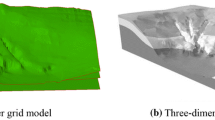Abstract
Road construction is accompanied with the occurrence of the cut slopes. Therefore, when the roads are constructed in mountainous terrain, the number of slopes is increased and the slopes are widely scattered in the regional area. In addition, the stability of rock cut slope is mainly dependent upon geological characteristics such as discontinuities in rock mass. In this study, the regional stability analysis technique based on Geographical Information System (GIS) was developed and applied to practical case, in which the road construction was planned and the planned cut slopes were widely scattered. GIS is the effective tool to deal with the widely scattered and the enormous number of data. Various factors affecting on the slope stability analysis, such as the structural domain, the orientation and dip angle of the cut slopes, and the friction angle of discontinuities, were considered as the input parameters for GIS. By overlaying input data layers and using the developed computer algorithm, the factor of safety (F.S.) values, as an index of slope stability were calculated for each failure mode, which considered for stereographic analysis and limit equilibrium analysis simultaneously. In this research, the factors of safety for each failure mode are evaluated and the minimum factor of safety is also evaluated in the divided small area. In order to verify the developed analysis method, the results of the cut rock slope stability were compared with actual failure modes and locations in the study area. Finally, the stable and economically appropriate cut angle for the planned rock slopes were suggested by using the developed algorithm and applying allowable F.S. value.
Similar content being viewed by others
References
Attewell, P.B. and Farmer, I.W., 1976, Principles of Engineering Geology. Chapman and Hall, London, 720 p.
Aydan, O., Shimizu, Y. and Ichikawa, Y., 1989, The effective failure modes and stability of slopes rock mass with two discontinuity sets. Rock Mechanics and Rock Engineering, 22, 163–188.
Barton, N., Lien, R. and Lunde, J., 1974, Engineering classification of rock masses for design of tunnel support. Rock Mechanics, 6, 189–236.
Bodonyi, J., 1970, Laboratory tests of certain rocks under axially symmetrical loading conditions. 2nd ISRM International Congress of Rock Mechanics, Belgrade, Paper 2–17.
Carrara, A., Cardinali, M., Detti, R., Guzzetti, F., Pasqui, V. and Reichenbach, P., 1991, GIS techniques and statistical models in evaluating landslide hazard. Earth Surface Processes and Landforms, 16, 427–445.
Franklin, J.A., 1971, Triaxial strength behaviour of some Indian coals. Journal of Mines Metals Fuels, 3, 86–98.
Gokceoglu, C., Sonmez, H. and Ercanoglu, M., 2000, Discontinuity controlled probabilistic slope failure risk maps of the Altindag (settlement) region in Turkey. Engineering Geology, 55 277–296.
Goodman, R.E., 1976, Methods of Geological Engineering. Institute of Mining & Metallurgy, London, 472 p.
Goodman, R.E., 2nd ed., 1989, Introduction to Rock Mechanics. John Wiley & Sons, 293 p.
Goodman, R.E. and Bray, J.W., 1977, Toppling of rock slopes. Proceedings of Special Conference on Rock Engineering for Foundation and Slopes. American Society of Civil Engineering, Boulder, 2, 201–234.
Gupta, R.P., 1990, Landslide hazard zoning using the GIS approach—A case study from the Ramganga Catchment, Himalayas. Engineering Geology, 28, 119–131.
Hobbs, D.W., 1964, The strength and stress-strain characteristics of coal in triaxial compression. Journal of Geology, 72, 214–231.
Hoek, E., 1970, Estimating the stability of excavated slopes in open cast mines. Transaction of Institute of Mineralogy and Metallurgy, London, 767, 109–132.
Hoek, E. and Bray, J.W., 3rd ed., 1981, Rock Slope Engineering. Institute of Mineralogy and Metallurgy, London, 358 p.
Hoek, E. and Brown, E.T., 1980, Underground Excavations in Rock. Institute of Mineralogy and Metallurgy, London, 527 p.
Hoek, E., Bray, J.W. and Boyd, J.M., 1973, The stability of a rock slope containing a wedge resting on two intersecting discontinuities. Quarterly Journal of Engineering Geology, 6, 1–55.
Kingsbury, P.A., 1992, Regional landslip hazard assessment using a GIS. Proceedings of the 6th International Symposium on Landslides, 2, 995–999.
Lee, D.S., 1987, Geology of Korea. Geological Society of Korea, Kyohak-sa, 514 p.
Leung, C.F. and Kheok, S.C., 1987, Computer Aided Analysis of Rock Slope stability. Rock Mechanics and Rock Engineering, 20, 111–122.
Luzi, L. and Pergalani, F., 1996, Applications of statistical and GIS techniques to slope instability zonation (1∶50,000 Fabriano geological map sheet). Soil Dynamics and Earthquake Engineering, 15, 83–94.
Luzi, L., Pergalani, F. and Terlien, M.T.J., 2000, Slope vulnerability to earthquakes at subregional scale, using probabilistic techniques and geographic information systems. Engineering Geology, 58, 313–336.
Matheson, G.D., 1983, Rock Stability Assessment in Preliminary Investigations Graphical Methods. Department of the Environment, Department of Transport, Transport and Road Research Laboratory, 1039 p.
Matheson, G.D., 1988, The collection and use of field discontinuity data in rock slope design. Engineering Geology, 22, 19–30.
Murrel, S.A.F., 1965, The effect of triaxial stress systems of the strength of rock at atmospheric temperature. International Journal of Rock Mechanics and Mining Science, 3, 11–43.
Park, H.J. and West, T.R., 2001, Development of a probabilistic approach for rock wedge failure. Engineering Geology, 59, 233–251.
Phillips, F.S., 3rd ed., 1971, The Use of Stereographic Projection in Structural Geology. Edward Arnold, 193 p.
Scavia, C., Barla, G. and Bernaudo, V., 1990, Probabilistic stability analysis of block toppling failure in rock slopes. International Journal of Rock Mechanics and Mining Science & Geomechanics (Abstract), 27, 465–478.
Singh, B. and Goel, R.K., 1999, Rock Mass Classification: A practical approach in civil engineering. Elsevier, 62 p.
Yudhbir, Lemanza, W. and Prinzl, F., 1983, An empirical failure criterion for rock mass. 5th International Congress of Rock Mechanics, Balkema, Melbourne, 1, b1–b9.
Author information
Authors and Affiliations
Corresponding author
Rights and permissions
About this article
Cite this article
Kim, KS., Park, HJ., Lee, S. et al. Geographic Information System (GIS) based stability analysis of rock cut slopes. Geosci J 8, 391–400 (2004). https://doi.org/10.1007/BF02910475
Received:
Accepted:
Issue Date:
DOI: https://doi.org/10.1007/BF02910475




